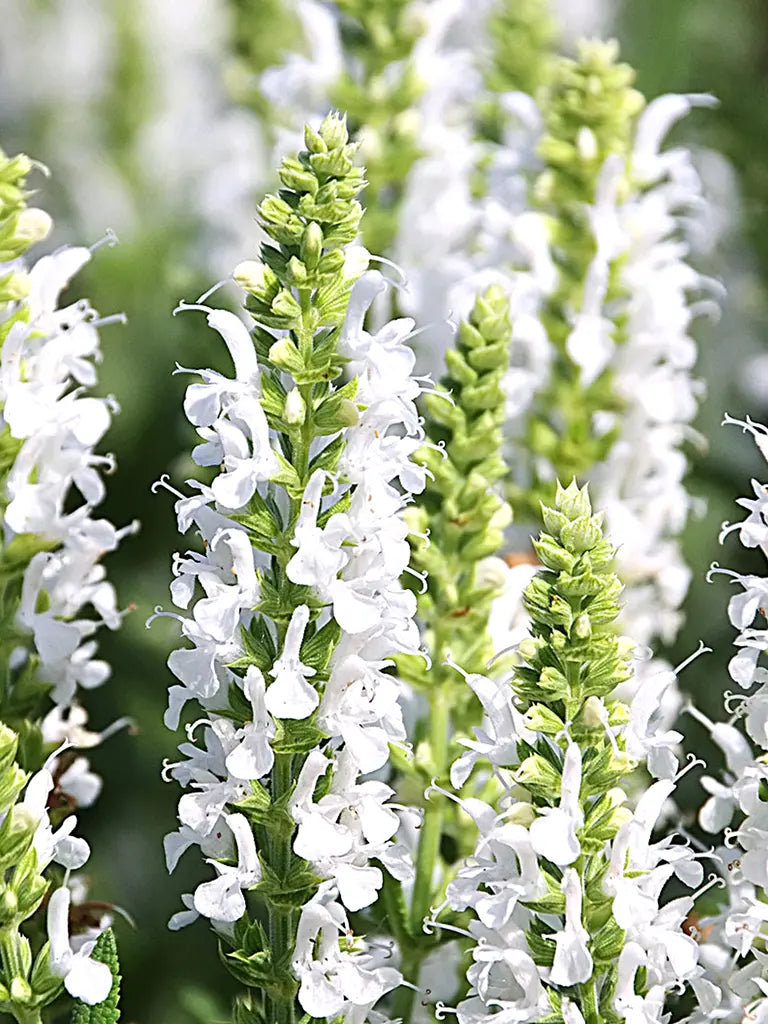Bloemoloog
Organic Salvia nemorosa 'Schneehügel' - White Woodland Sage
Organic Salvia nemorosa 'Schneehügel' - White Woodland Sage
Estimated Shipping Widget will be displayed here!
Couldn't load pickup availability
Organic white Woodland sage
The white Salvia nemorosa 'Schneehügel' , also called 'woodland sage' or 'White sage', blooms with long sturdy flower spikes of about 60 centimeters high. The flowers themselves consist of numerous small white lipped flowers that grow in dense flower clusters. The leaves are lanceolate, meaning they are elongated and pointed. The leaf has light hair, which gives it a soft appearance. The scent of the leaf is spicy and aromatic. So adding Salvia nemorosa 'Schneehugel' to your garden can not only be visually appealing, but also sensorially appealing due to its scent.
It blooms from June to August and in good weather conditions it can bloom again in the autumn when the spent flower stems are cut off.
Like many other salvias, 'Schneehügel' attracts pollinating insects such as bees and butterflies. This contributes to the ecological value of the plant and can also be beneficial for other plants in your garden.
How, where and when do I plant woodland sage?
Sage is a perennial plant that can be planted all year round. The rhizomes can be planted immediately after receipt. Plant all roots so deep that the young green leaves are just above the ground.
Plant it in a sunny position in well-drained soil. Sandy or loamy soils are ideal because they drain excess water and keep roots healthy. Heavy clay soils can become too moist and the plants may be susceptible to root rot. Improving soil structure by adding organic matter such as compost can improve drainage.
Plant it in the center of the border or in pots, together with the purple Salvia nemorosa 'Caradonna' or with the slightly lower Oxalis deppei 'Iron Cross'.
Care of the woodland sage
Provide plenty of water, especially during dry spells, and consider using a mulch around the plant to retain moisture.
After the first flowering in the summer, the spent flower stems are cut off for a possible second flowering in the autumn. The following spring, the dead or damaged parts can be removed to stimulate new growth.
Provide a balanced diet annually for best results. We recommend Bio Kultura for organic potting soil, plant food and other soil improvers !
Propagation
After 5 years the rhizomes can be divided. (This can also be done earlier, but we recommend doing this every 5 years.) Tear or cut the root into smaller pieces and distribute them in other places in the garden. This way the plant is rejuvenated and grows well again.
Use as a herb
The herb sage is popular in the kitchen, for example in salads or hot dishes, because it has many good properties.
Tea can be made from the fresh and dried leaves of sage. This has a beneficial effect on respiratory diseases such as asthma.
White sage is widely used as incense.
Buy Organic Salvia nemorosa 'Schneehügel' - Skal NL-BIO-01 certified: 109459
Packaged individually or choose a stacking discount!
Stacking discount: B
Can be ordered from January '26!
EU shipping €8.95 - Free shipping from €100 purchase.
Note: you are buying the bare roots!
Characteristics
| Flowering time: | June - August |
| Planting time: |
All year round |
| Planting depth: |
Green above the ground |
| Planting distance: | 7 per m² |
| Height: |
60 cm high |
| Flower diameter: |
5cm wide |
| Location: |
Partial shade, sun |
| Soil PH: | Loam, sandy soil - Slightly alkaline/neutral |
| Winter hardiness: |
Extremely hardy |
| Propagation: | Good |
| Origin: | Central Asia |
| Family: | Lamiaceae (lipflower family) |
| Colour: | White |
| Bee-friendly: | Yes |
| Fragrant: | Yes |
| Quality: | Undivided |
Other sage:
- Bio Salvia nemorosa 'Caradonna'

NL-BIO-01
To share






